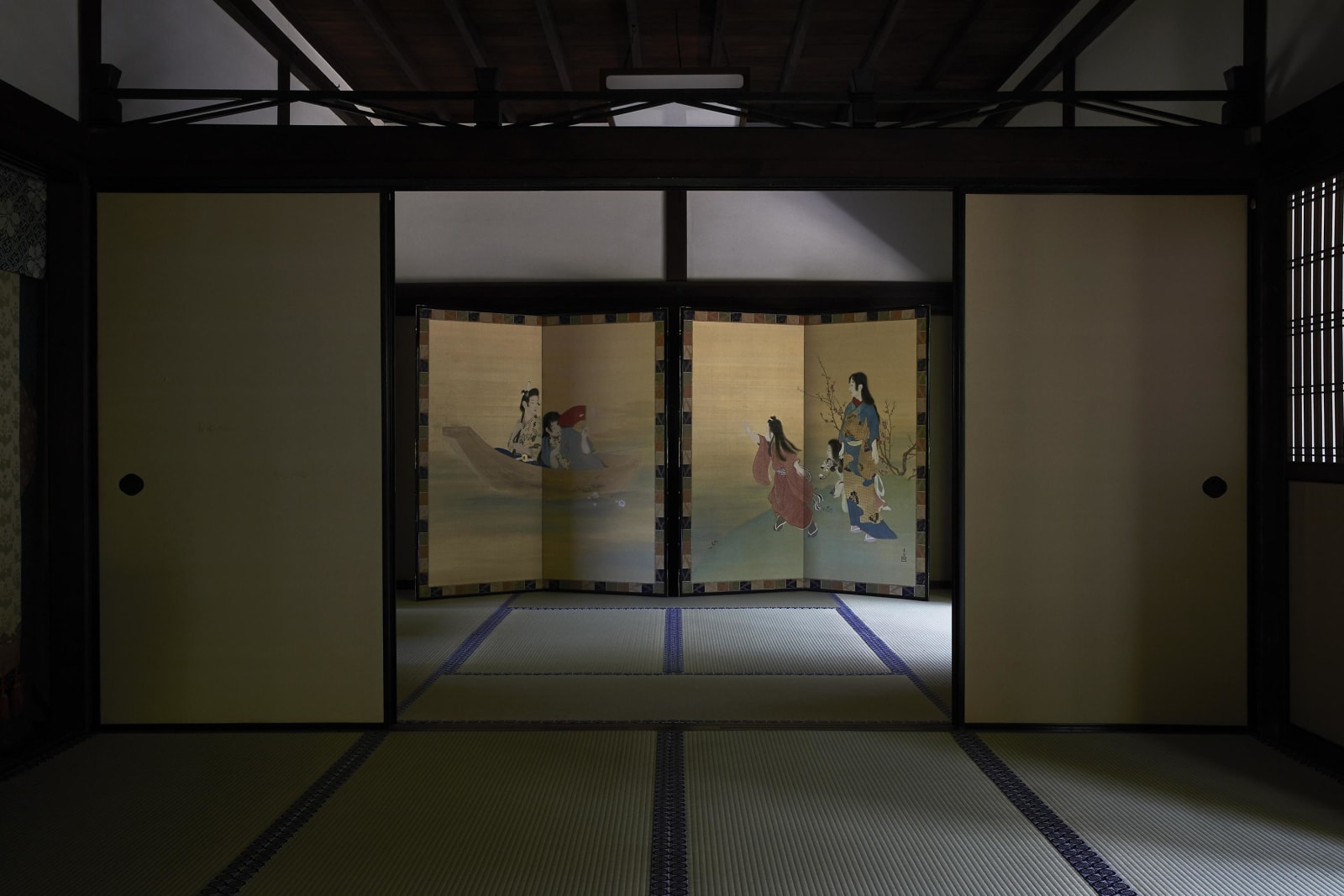Kaburaki Kiyokata (1878−1972)
Young Boys and Girls
Color and gold on silk, a pair of two-panel folding screens
Seal: Kiyokata
176 x 170 cm each (overall)
Seal: Kiyokata
176 x 170 cm each (overall)
Further images
Exhibitions
The Twelfth Tatsumi gakai. Tokyo: Takenodai Chinretsukan, Mino: Mino Kokaido, 1912.Literature
Kaburaki Kiyokata gashu. Tokyo: Vision Planning & Publishing, 1998.Kaburaki Kiyokata. Bessatsu Taiyo 152. Tokyo: Heibonsha, 2008.
It is a vista depicting the young boys and girls playing at leisure along the spring pond and the flowers falling or resting on the water. According to the shape of the flowers or the cherry blossom pattern, as an emblem of the season, on the clothes of a female sitting in the boat, we may be aware that the flowers are camellias rather than sasanquas. The female hiding her face behind the folding fan is supposedly the elder sister of those waving the hands on the shore, appearing to enjoy the hide-and-seek game. Such composition delivers not only the spring tranquility but a genial atmosphere throughout the screens.
Born in Kanda of Tokyo in 1878 (Meiji 11), the infant Kaburaki Kiyokata had a last chance to immerse himself in the charms of the Edo culture which remained in the early Meiji period. Learned from such experience, Kiyokata excelled at elaborately depicting the life of shitamachi, or the commoner area in lowland of Edo. Later, his ambition was expanded from the adoration of Edo gradually to the genre scene of the beginning of the early modern time. In the present screens, the attire, the coiffure or even the expression in features of the figures faithfully reproduced the atmosphere of the early seventeenth century. This work, surpassing what is called Kiyokata’s beauty, is fair to be praised as one of his masterpieces.
This work was awarded the second prize of the twelfth Tatsumi Gakai Exhibition, and was displayed at Takenodai Exhibition Hall in Ueno, Tokyo, from April 3 to 29, 1912, and Mino Public Hall in Osaka from May 11 to 19.
Kaburaki Kiyokata (nihonga painter; 1878−1972)
Tokyo-born nihonga painter. His real name is Ken’ichi. Became Mizuno Toshikata’s apprentice at the age of fourteen and drew illustrations for newspapers and magazines. Founded Ugo-kai, and later Kinrei-sha. Well-versed in the culture of Edo period, and painted many excellent figures of beautiful women which reflect a Japanese aesthetic sense of iki (chic). Also excelled as a writer and left a lot collection of essays such as Koshikata-no-ki. Designated as an Imperial Court Artist. Member of the Japan Art Academy. Person of Cultural Merit. Received the Order of Culture.
Born in Kanda of Tokyo in 1878 (Meiji 11), the infant Kaburaki Kiyokata had a last chance to immerse himself in the charms of the Edo culture which remained in the early Meiji period. Learned from such experience, Kiyokata excelled at elaborately depicting the life of shitamachi, or the commoner area in lowland of Edo. Later, his ambition was expanded from the adoration of Edo gradually to the genre scene of the beginning of the early modern time. In the present screens, the attire, the coiffure or even the expression in features of the figures faithfully reproduced the atmosphere of the early seventeenth century. This work, surpassing what is called Kiyokata’s beauty, is fair to be praised as one of his masterpieces.
This work was awarded the second prize of the twelfth Tatsumi Gakai Exhibition, and was displayed at Takenodai Exhibition Hall in Ueno, Tokyo, from April 3 to 29, 1912, and Mino Public Hall in Osaka from May 11 to 19.
Kaburaki Kiyokata (nihonga painter; 1878−1972)
Tokyo-born nihonga painter. His real name is Ken’ichi. Became Mizuno Toshikata’s apprentice at the age of fourteen and drew illustrations for newspapers and magazines. Founded Ugo-kai, and later Kinrei-sha. Well-versed in the culture of Edo period, and painted many excellent figures of beautiful women which reflect a Japanese aesthetic sense of iki (chic). Also excelled as a writer and left a lot collection of essays such as Koshikata-no-ki. Designated as an Imperial Court Artist. Member of the Japan Art Academy. Person of Cultural Merit. Received the Order of Culture.







